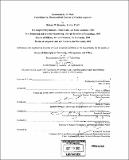Command in air war : centralized vs. decentralized control of combat airpower
Author(s)
Kometer, Michael W
DownloadFull printable version (21.04Mb)
Other Contributors
Massachusetts Institute of Technology. Technology, Management, and Policy Program.
Advisor
David A. Mindell.
Terms of use
Metadata
Show full item recordAbstract
This study answers the question, "What has been the impact of the Information Age on the Air Force's doctrinal tenet of "centralized control and decentralized execution?" It traces the evolution of command and control of airpower through operations Desert Storm, Allied Force, Enduring Freedom, and Iraqi Freedom and compares its practice with classic theories established by Huntington, Cohen, Van Creveld, and Air Force doctrine. In the absence of a peer superpower in the 1990s, U.S. decision-makers often resorted to the use of detailed constraints to gain direct influence on military operations. The more detailed the constraints from the strategic level, the closer the theater military commander held authority for planning air strikes, and the less proactive the air component was in coordinating with other components. The Air Force developed the Air Operations Center (AOC) to put together battlespace information; it is not yet possible to do this at lower levels, so the AOC has become dominant in controlling air operations. Initially resistant to get involved in ongoing missions, commanders found the AOC was needed to accomplish some "time-sensitive targeting" missions; however, they have also learn to delegate to speed up the processes. (cont.) But the insertion of the AOC into ongoing operations also led to distribution of tasks-where before the aircrew had performed the whole "kill chain" sequence, now the aircrew often performed only the end game tasks. This distribution could increase the potential for system accidents because people tend to drift from procedures during slack times and thus to be disintegrated when the system becomes tightly coupled. Technology has not changed the fundamental principles of command and control. The information, telecommunications, sensor and weapons technology have altered the way these humans perform their jobs, and even the jobs they perform. But commanders still need to cultivate a learning organization. Uncertainty and the coupling of diverse organizations still require that they balance empowerment with accountability by developing depth in the command relationships among their subordinates. Commanders can best gain this depth through deliberate delegation, a bruising debate, and assessment of results rather than management of specific details.
Description
Thesis (Ph. D.)--Massachusetts Institute of Technology, Engineering Systems Division, Technology, Management, and Policy Program, 2005. Includes bibliographical references.
Date issued
2005Department
Massachusetts Institute of Technology. Engineering Systems Division; Technology and Policy ProgramPublisher
Massachusetts Institute of Technology
Keywords
Technology, Management, and Policy Program.